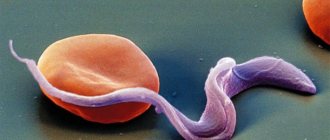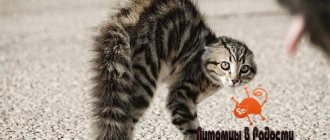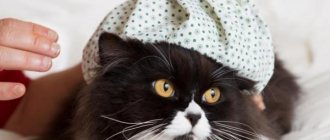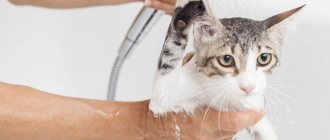Cat diseases are difficult to diagnose independently, as their signs often overlap. Due to late visits to the veterinarian, treatment becomes ineffective, which worsens the chances of a successful recovery. Understanding the basic symptoms that appear when your health worsens and following preventive measures that reduce the likelihood of developing pathologies will help you avoid sad consequences.
How to tell if your cat is not okay
The prognosis for the treatment of cat diseases depends on the symptoms and the time of their detection. Changes in the pet’s usual state are:
1. Behavioral.
If an active and always hungry cat spends the entire day on the couch, avoids communication and refuses his favorite food, sound the alarm. Reverse changes are no less dangerous. Excessive activity and increased appetite, which are not characteristic of an animal, are a sign of a malfunction within the body.
2. Physiological.
This group includes more obvious violations that are understandable not only to the owner, but also to an outsider:
- intestinal disorder (diarrhea, constipation);
- difficulty urinating;
- nausea and vomiting;
- the appearance of redness and peeling on the skin;
- hair loss;
- loss of coordination;
- increase or decrease in normal temperature;
- increased or slow heart rate;
- excessive discharge from the eyes, nose or ears.
Of particular danger is the appearance of blood in stool or vomit. This symptom always accompanies internal injuries and requires urgent assistance from a veterinarian.
Cat flu: treatment
Cat flu, which must be treated without fail, requires an integrated approach. To begin with, a sick pet must be separated from others, if there are any in the house. The treatment room should be draft-free. The entire treatment system is prescribed by a veterinarian. And here it is important to understand that drugs for humans are not suitable for animals.
If we consider the general principle of treatment, the following drugs are usually prescribed:
- immunomodulators that increase the body's defenses;
- symptomatic therapy in the form of drops, ointments and sprays;
- antiviral therapy;
- antipyretic therapy if the cat has a fever.
If a secondary infection develops, antibiotics are offered. And the owner will have to monitor compliance with the drinking regime to avoid deadly dehydration. Sometimes you have to force yourself to drink. If the cat refuses to eat and is already close to exhaustion, he may need IVs.
Cat flu is a disease that is not fatal in itself for a four-legged animal, but entails serious consequences in case of complications. Therefore, it is necessary to seek qualified help as quickly as possible and carry out all measures prescribed by the veterinarian.
Description of diseases with symptoms and prevention
Cat diseases are classified according to the place of occurrence and causes of infection. Most often they affect the skin, organs of vision and hearing, teeth, genitourinary system, gastrointestinal tract, cardiovascular and musculoskeletal systems. The risk group includes unvaccinated and uncastrated animals. They are especially vulnerable to infectious and oncological pathologies.
Viruses and infections
Infectious diseases in cats are caused by single-celled microorganisms: viruses, bacteria and fungi. The most dangerous are pathologies of viral etiology. They constantly mutate and retain their pathogenic properties for a long time, even in the external environment.
Panleukopenia (distemper)
Panleukopenia is transmitted through direct contact with an infected person and his biological fluids (urine, saliva). It is easily transferred to clothing and shoes, so the only effective method of prevention is vaccination. Lack of vaccination increases the risk of complications and death. When infected, the following are observed:
- fever;
- weakness and apathy;
- loss of appetite;
- foamy yellow or green vomit;
- foul diarrhea;
- the appearance of skin inflammations, gradually filling with purulent contents.
Distemper is especially dangerous in kittens - without urgent treatment, the probability of death tends to one hundred percent.
Calcivirosis
Animals become infected through nutrition (contact with an infected person) or aerogenously (care items, clothing). To protect against calcivirus, mandatory vaccination is recommended for up to a year. Infected people develop:
- fever;
- leakage of serous fluid from the eyes and sinuses;
- profuse drooling;
- swelling and ulcers on the skin.
In kittens, calcivirosis progresses rapidly, so immediately after detecting suspicious symptoms, you need to take the baby to a veterinarian.
Rhinotracheitis
The virus spreads in a similar way to plague and calcivirus. The risk of infection is reduced by complex vaccination at 2-3 months, and then by annual vaccination. When infected it is noted:
- lethargy and loss of appetite;
- increased body temperature;
- runny nose with discharge of serous or purulent fluid;
- cough and shortness of breath;
- ulcer of the cornea and tongue.
In terms of symptoms, rhinotracheitis is similar to chlamydia, but it is not dangerous for people and other pets.
Salmonellosis
The pathogen enters the body along with fish or meat that has not undergone heat treatment. Its symptoms are similar to feline distemper, but are easier to treat. These include:
- lethargy;
- a sharp increase in temperature;
- frequent vomiting and diarrhea interspersed with blood;
- profuse drooling;
- convulsions;
- discharge of pus from the sinuses.
Advanced salmonellosis leads to bronchopneumonia and is especially dangerous for kittens.
Trichophytosis (ringworm)
The risk of fungal infection occurs with low immunity. Ringworm is contagious to all mammals, including humans, and treatment lasts at least 1 month. After the first symptoms of this disease are detected, the cat is diagnosed and treatment begins. You should contact your veterinarian if:
- severe itching;
- peeling and inflammation;
- hair loss;
- pigmentation changes.
For preventive purposes, vaccination is acceptable, but it is less effective than vaccination against panleukopenia. Regular cleaning of the premises, timely administration of anthelmintics, high-quality nutrition and preventive examinations by a veterinarian will help to avoid infection.
Parasitic infections (helminthiasis, flea and tick infestations)
Parasitoses are placed in a separate group. They are accompanied by itching, partial baldness and bowel dysfunction. To protect against parasites, it is recommended to carry out regular antiparasitic treatment and avoid contact with unfamiliar animals.
Skin problems
Skin problems not related to body trauma are caused in two ways: infectious and allergic. Each of them requires specific treatment.
Infestation with scabies mites (otodectosis, demodicosis, sarcoptic mange, notoedrosis)
Parasites are transmitted through direct contact with an infected person or with his personal belongings. An exception is the demodex canis mite, which causes demodicosis. It lives in the body from birth, but becomes pathogenic only with a sharp drop in immunity. If a cat is sick, then soon its entire body will be covered with scabies. When infected, the following appears:
- constant itching;
- excessive hair loss, leading to the formation of bald spots and bald spots;
- inflammation of the lymph nodes;
- nodular rash filled with thick fluid;
- severe pain at the site of redness and suppuration.
Unlike humans, for whom scabies mites are not life-threatening, cats can die. This happens in advanced cases when parasites have penetrated into the internal organs.
Allergy
Most often, pets experience atopic dermatitis (an allergy to pollen and other environmental components) and an allergic reaction to flea bites. Food allergies are also common, especially in albinos or sensitive breeds. This is an individual reaction of the body to certain irritants, so it is difficult to avoid it with preventive measures. Allergy attacks are suppressed with glucocorticoids and antihistamines. They appear:
- itching;
- small rash;
- partial baldness and dandruff formation;
- the appearance of granulomas and ulcers on the body.
The danger of skin diseases in cats is the high probability of secondary infection. Open wounds attract pathogenic microorganisms, so it is important to eliminate them first.
Pathologies of the oral cavity
With insufficient oral hygiene or eating only soft foods, tartar forms on the teeth. Due to the accumulation of plaque, the surface of the tooth is damaged. Bacteria penetrate into it, damaging the enamel and gums. A sick pet develops caries or periodontitis. Older animals have a poor prognosis and often require removal of damaged teeth.
Gum damage is accompanied by:
- low appetite;
- unpleasant odor from the mouth;
- profuse salivation;
- the formation of yellow-brown deposits on the enamel;
- redness and inflammation of the gums.
For preventive purposes, it is recommended to regularly clean your mouth. It is also important to combine dry and wet feeding. Hard pieces of dry food clean the surface of the tooth, and soft food relieves stress on the gums.
Eye and ear diseases
Ophthalmological diseases in cats are very dangerous and can lead to loss of vision. The most common:
- Conjunctivitis
. The main causes of damage to the mucous membrane of the eye are mechanical injuries, chemical poisoning, bacterial infection and allergies.
- Blepharitis
. Damage to the cornea is caused by parasites or internal disorders (problems with hormones, sebaceous glands or autoimmune diseases).
The symptoms of these pathologies are similar and include:
- redness and swelling of the mucous membrane;
- increased lacrimation and swelling of the eyelids;
- difficulty opening eyes.
Regular eye examinations and the use of Diamond Eyes drops, which have an antibacterial effect, will help you avoid unpleasant consequences.
Ear care is also important, which involves weekly cleansing of accumulated plaque. Otherwise, otitis may occur, accompanied by:
- change in behavior (lethargy, anxiety and aggression);
- shaking the head due to itching;
- formation of redness and brown discharge in the ear.
Similar symptoms occur with otodectosis - infection with ear mites. Without timely treatment, hearing loss may occur. The risk group includes kittens and older individuals.
Diseases of the genitourinary system
Urolithiasis in cats occurs due to feeding with low-quality food, as well as low activity and excessive body weight. Its symptoms include:
- difficulty urinating;
- the appearance of blood in the urine;
- severe pain;
- restless behavior and refusal to eat.
In advanced cases, the bladder may rupture, which can be fatal for the pet. A balanced diet, weight control and regular physical activity will help avoid the development of urolithiasis.
Gastrointestinal disorders
Gastrointestinal upset is always accompanied by vomiting, diarrhea or constipation. More pronounced symptoms depend on the specific type of pathology:
- Diabetes
. Accompanied by increased thirst and frequent urination. In a complicated form, it is fraught with coma, which can be stabilized. The disease is typical for cats with a sedentary lifestyle that have not been castrated.
- Gastritis
. Accompanied by the appearance of a white coating on the tongue and an unpleasant odor from the mouth. It often becomes chronic and is associated with poor quality feeding.
For prevention purposes, monitor the amount of food you eat and avoid overeating. Play with your pet regularly and monitor its weight.
Cardiovascular pathologies
Every tenth cat is diagnosed with hypertrophic cardiomyopathy. It is accompanied by rapid heartbeat and fainting. Other symptoms (lethargy, rapid fatigue) are hardly noticeable, so treatment is not always provided in a timely manner. This disease in cats is genetic and cannot be prevented. The only way to avoid complications is to regularly visit the veterinarian. The sooner the problem is diagnosed, the less likely the consequences.
Other cardiac pathologies (for example, heart attack) are very rare in cats.
Oncology
At an early stage, oncology is difficult to diagnose due to vague symptoms. Common diseases include:
- sarcoma;
- carcinoma;
- lymphoma.
The patient's appetite decreases, bowel dysfunction occurs, and body weight decreases sharply. Malignant neoplasms appear on the body: spots, bumps, swellings, ulcers. When palpated, they cause pain and can grow on neighboring tissues.
Unvaccinated and uncastrated animals are more vulnerable to cancer. For prevention purposes, it is recommended to sterilize your pet before the first heat, and neuter the cat before the age of one year.
Musculoskeletal disorders
Problems with the musculoskeletal system reduce activity. In advanced cases, they develop into a chronic form. Most often diagnosed:
- Arthritis
. Occurs due to obesity or injury. Swellings that appear in the joint area are accompanied by pain when palpated.
- Arthrosis
. Develops with excessive physical exertion and low amounts of phosphorus and calcium. Leads to lameness, crunching in the joints and their deformation.
Both arthritis and arthrosis have similar symptoms. Only a veterinarian can determine the type of violation - after diagnosis, treatment will be prescribed and the basics of caring for a sick animal will be prescribed.
To prevent possible complications, keep your diet balanced. When feeding naturally, be sure to add vitamins to the food, approved by your veterinarian.
Obesity
Obesity in neutered cats is a common phenomenon that causes severe discomfort to the animal. The fact is that castration makes pets too calm, they can move little, but at the same time eat a lot, which leads to excessive weight gain.
The causes of the disease may be the following:
- poor nutrition. Excessive overfeeding of the pet;
- metabolic problems;
- sedentary lifestyle;
- hereditary predisposition;
- presence of hormonal imbalance;
- castration and sterilization;
- age factors. Typically, in old age, cats become inactive, which leads to weight gain.
Note! Obesity can lead to diseases of many internal organs, cause hormonal imbalances, have a negative effect on joints and bones, and also cause pathologies with the cardiovascular system.
For this reason, it is necessary to treat this disease at a very early stage.
Diagnosis of the disease can be done at home. A visual examination of the animal can immediately show excess weight - a layer of fat on the abdomen, poor palpation of the spine and ribs.
The role of physical activity in the treatment of obesity in cats is of great importance. Constantly play outdoor games with your pet to make him run and jump. Take him outside regularly. Also, do not forget about proper nutrition. Do not overfeed your pet, give food three times a day. For feeding it is worth using vegetables, lean meats, and fermented milk products.
Diseases common in kittens
For kittens, pathologies accompanied by vomiting and diarrhea are especially dangerous. The likelihood of death with rapid dehydration is maximum. Babies can catch the infection both from outside and from their mother. Therefore, it is especially important to protect very young kittens that have not yet been vaccinated.
Most often, kittens are diagnosed with the following diseases:
- Otodectosis
. If intense itching, redness and brown-black discharge from the ears appear, not only the infected person, but also other pets are treated.
- Flea infestations
. Severe infection can lead to anemia. Fleas can also be carriers of mycoplasmas and infect the baby with mycoplasmosis.
- Panleukopenia
. When infected, a fulminant form is often observed. The baby fades away within a day.
- Upper respiratory tract infections (calcivirosis, rhinotracheitis)
. Accompanied by a runny nose, sneezing and lacrimation. It spreads quickly from one animal to another and requires mandatory treatment.
- Helminthiasis
. Intestinal parasites can be transmitted through breast milk or through contact with outdoor shoes. Worm the animals before mating and keep the kittens in an enclosure until the first vaccination and anthelmintic treatment.
For the health of your fur baby, vaccinate it immediately after separation from its mother. This will help protect it from most dangerous infections.
Rabies
The most dangerous viral zoonotic disease is rabies. The disease is characterized by the following symptoms:
- The causative agent is myxovirus.
- Carriers are stray dogs, cats, wild carnivores.
- Infection - through saliva from the bite of a sick animal or defects in the skin and mucous membranes.
- Incubation period. After the bite, the animal is observed for 10 days. If no clinical manifestations occur, the animal is considered healthy.
- Symptoms are nervous phenomena.
- Forms of the disease:
- Violent. Excessive drooling, aggressive behavior, perversion of appetite, paralysis. Photophobia, hydrophobia. After 3-11 days the animal dies.
- Paralytic. Lasts up to 4 days. Paralysis occurs without an aggressive phase.
- Atypical. Symptoms erased. Ends in paralysis and death.
- Diagnostics:
- Lifetime - based on anamnesis, epizootic situation, clinical symptoms.
- Post-mortem - histological examination of the brain.
- Treatment. Injection of specific serum within 72 hours. If symptoms appear, treatment is ineffective.
- Prevention - annual vaccination.
Rabies in a cat
Age-related diseases of cats
In older cats, most diseases are associated with a gradual decline in immunity. Due to disruptions in the immune system, the following develops:
- diabetes;
- renal and liver failure;
- hypertrophic cardiomyopathy;
- thyroid diseases;
- arthritis;
- inflammation of the gums
There are other ailments that are dangerous for old cats, but the ones listed are the most common. If the pet has not given birth and has not been sterilized, then there is a high risk of developing malignant tumors on the mammary glands or pyometra (uterine abscess). Their removal often requires surgery performed under general anesthesia. It is difficult to tolerate in old age, so be sure to sterilize non-breeding animals immediately after puberty.
Pay special attention to nutrition - the veterinarian will tell you which diet is suitable for an older pet. Ideally, your cat should be examined by a veterinarian every six months after reaching 10 years of age. This will include an examination and blood sampling.
Cystitis
One of the common diseases in cats after castration is cystitis of the bladder. In cats, this disease is provoked by various reasons:
- infectious diseases;
- diseases that occur in a chronic form. During them, a weakening of the immune system is observed;
- poor nutrition;
- drinking stale or dirty water;
- hypothermia;
- stressful situations.
If cystitis is detected in a cat, the veterinarian may prescribe various medications:
- Stop cystitis. This remedy eliminates the symptoms of the disease, alleviates the condition of the animal;
- Urotropin. Used in the treatment of mild forms of the disease;
- Antibiotics are recommended to be taken in the presence of bacterial microflora;
- Furacelin is used for exacerbation of cystitis.
In addition to taking medications, the doctor will prescribe proper nutrition. It is the correct diet that is considered the basis of treatment. A special diet will help strengthen the animal’s immunity and increase the protective properties of its body.











